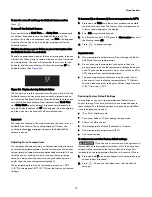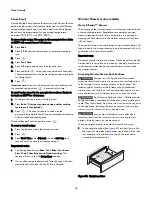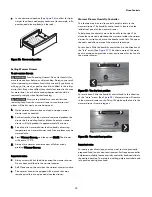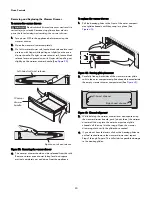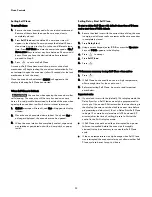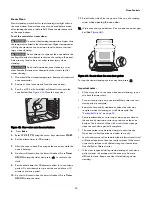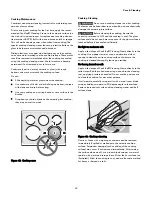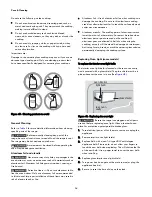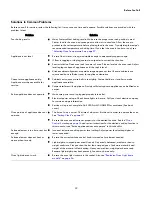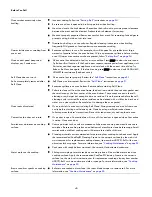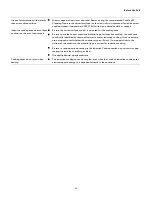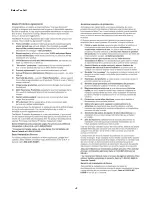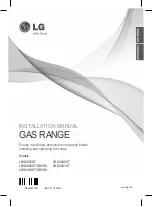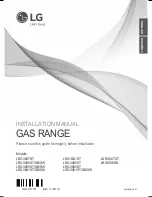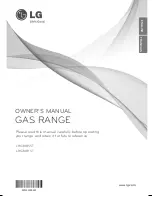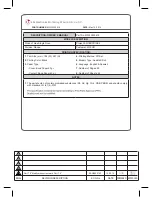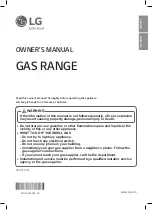
40
Before You Call
Oven smokes excessively when
broiling.
•
Incorrect setting. Follow the
“Setting Broil”
instructions on
page 24
.
•
Be sure oven door is opened to broil stop position when broiling.
•
Meat too close to the broil element. Reposition the broil rack to provide proper clearance
between the meat and the element. Preheat the broil element for searing.
•
Meat not properly prepared. Remove excess fat from meat. Cut remaining fatty edges to
prevent curling, but do not cut into lean.
•
Grease has built up on oven surfaces. Regular cleaning is necessary when broiling
frequently. Old grease or food spatters cause excessive smoking.
Flames inside oven or smoking from
oven vent.
•
Excessive spillovers in oven. For example, this will happen for pie spillovers or large
amounts of grease left on the oven bottom. Wipe up excessive spillovers before starting
oven. If flames or excessive smoke are present, follow
“Setting Broil”
on
page 24
.
Oven control panel beeps and
displays any F code error.
•
Oven control has detected a fault or error condition. Press STOP to clear the error code.
Try Bake or Broil function. If the F code error repeats, remove power from appliance, wait
5 minutes, and then repower appliance and set clock with the correct time of day. Try
Bake or Broil function again. If the fault recurs, press STOP to clear and call 1-800-4-MY-
HOME® for assistance (See back cover).
Self Clean does not work.
•
Oven control not set properly. Review the
“Self Clean”
instructions on
page 31
.
Soil not completely removed after
Self Clean.
•
Self Clean was interrupted. Review the
“Self Clean”
instructions on
page 31
.
•
Excessive spillovers on oven bottom. Remove before starting Self Clean.
•
Failure to clean soil from the oven frame, the door liner outside the oven door gasket and
the small area at the front center of the oven bottom. These areas are not in the self-
cleaning area, but get hot enough to burn on residue. Clean these areas before the self-
cleaning cycle is started. Burned-on residue can be cleaned with a stiff nylon brush and
water or a nylon scrubber. Be careful not to damage the oven gasket.
Oven racks discolored.
•
Oven racks left in oven cavity during Self Clean. Always remove oven racks from oven
cavity before starting a self-clean cycle. Clean by using a mild, abrasive cleaner
following manufacturer's instructions. Rinse with clean water, dry and replace in oven.
Convection fan does not rotate.
•
Oven door is open. Convection fan will turn off if oven door is opened when Convection
is active. Close oven door.
Scratches or abrasions on cooktop
surface.
•
Coarse particles such as salt or hardened soils between cooktop and utensils can cause
scratches. Be sure cooktop surface and bottoms of utensils are clean before usage. Small
scratches do not affect cooking and will become less visible with time.
•
Cleaning materials not recommended for ceramic-glass cooktop have been used. Apply
the recommended CookTop® Cleaning Creme to the ceramic surface (on the web visit
www.sears.com for replacement cooktop cleaner, item number 40079). Buff with a non-
abrasive cloth or sponge. For more information, see
“Cooktop Maintenance”
on
page 35
.
•
Cookware with rough bottom was used. Use smooth, flat-bottomed cookware.
Metal marks on the cooktop.
•
Sliding or scraping of metal utensils on cooktop surface. Do not slide metal utensils on
cooktop surface. Apply the recommended CookTop® Cleaning Creme to the ceramic
surface (on the web visit www.sears.com for replacement cooktop cleaner, item number
40079). Buff with a non-abrasive cloth or sponge. For more information, see
“Cooktop
Maintenance”
on
page 35
.
Brown streaks or specks on cooktop
surface.
•
Boilovers are cooked onto surface. Use razor blade scraper to remove soil. For more
information, see
“Cooktop Maintenance”
on
page 35
.
Summary of Contents for 790.9507 Series
Page 42: ...42 Before You Call ...
Page 43: ......


